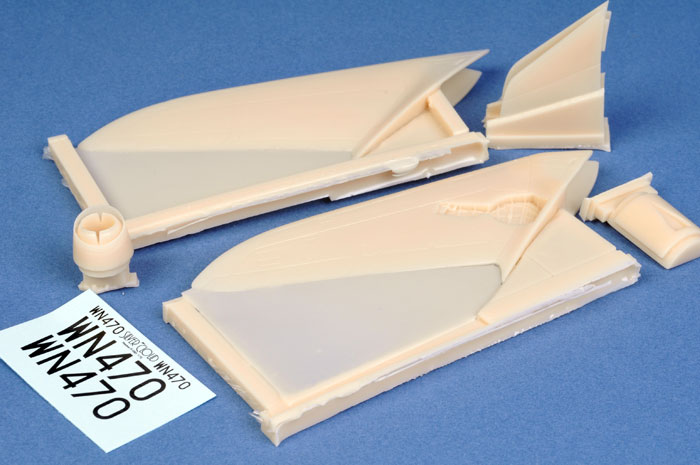Hawker P.1083
“Super Hunter” Conversion

Silver Cloud,
1/72 scale
S u m m a r y : |
Catalogue Number: |
SCC7201 |
Scale: |
1/72 |
Contents & Media |
6 x cream resin airframe parts |
Price: |
£10.99 available online from Freightdog Models |
Review Type: |
First Look |
Advantages: |
Nicely cast, simple to use |
Disadvantages: |
None |
Conclusion: |
Suitable as a first resin conversion, and highly recommended. |
Reviewed by Mark J. Davis

HyperScale is proudly sponsored by
Squadron.com
The RAE first recommended an aircraft with 50 degree sweepback and capable of supersonic level flight in September 1949. It advocated development of an existing design to simplify development of research prototypes. Both Supermarine and Hawker responded to this proposal. The P.1083 being Hawker’s response and early design work on this supersonic Hunter began late in 1951.
First flight of the ‘Super Hunter’ was planned for the middle of 1953. The new aircraft was to feature redesigned thinner and more highly swept wings and tail surfaces mated to mated to the original P.1067 fuselage (this being the prototype airframe that later became the Hawker Hunter). Initially an after-burning Sapphire engine was planned, but in the end an after-burning Avon engine was selected. The fourth P.1067 airframe, number WN470, was selected to be the proof of concept prototype.
The P.1083 should have resulted in an aircraft comparable with the genuinely supersonic types slated for introduction to various other air forces in the mid-to-late 1950’s. But with the end of the Korean War and the defence cut backs that followed, the RAF showed more interest in a more powerful but non-after-burning development of the Hunter, with a more economic fuel burn. And so the P.1083 was officially cancelled in July of 1953.
Parts of the partially completed P.1083 prototype (including the forward fuselage) were used to build the Hawker P.1099 under serial XF833, which was to become the prototype Hunter F.6.
Silver Cloud is part of Freightdog Models who seem to have a penchant for cancelled British fighter projects of the 1950’s. Their resin casting is carried out by A2zee Models, and is of very high standard. The conversion is intended for use with Revell’s excellent Hunter F.6 kit, which should be readily available from numerous sources.
The conversion comes in a plain, stout top-opening box. The parts are enclosed in a zip-lock plastic bag and are bubble-wrapped for additional protection. Instructions and decals round out the package.
Instructions on an A4 page giving a brief history of the “Super Hunter” accompany the conversion. The instructions’ written notes go on to integrate themselves with those of the Revell donor kit. These cross-reference each stage from the Revell instructions, and are clear and easy to follow.
The kit parts consist of wings, horizontal stabiliser, after-burning jet nozzle and an insert with NACA duct for the lower rear fuselage. They are cast to an excellent standard and require minimal cleanup after removal from their casting blocks. I could see no pinholes worth mentioning.
The conversion is very simple. The only cutting of plastic required is removal of the tail-fin bullet from the donor kit, and the removal of a 17mm section in the lower rear fuselage. This process is well explained by identifying the kit panel lines to be used as a cutting guide, and a clearly drawn diagram illustrates what is required to be done. Once cut out a replacement resin section with the NZACA duct is to be inserted and blended in.
The tailpipe is nicely cast with the simple two-part variable after-burner nozzle well represented. I feel that the nozzle is a little shallower than could have been achieved, being about 6mm deep. Some may wish to drill this out an incorporate some additional jet pipe. This is a minor quibble however.
Some nicely printed decals provide for under-wing and fuselage serial numbers for WN470, and the instructions suggest Duck-Egg Blue as a colour for the finished model.
This is a very well executed conversion for an attractive and interesting Hunter variant that almost came into being. It is suitable as a first resin conversion because both the conversion and donor kits are such good quality, and the cutting and filling required is simple
Highly recommended for any fans of British post-war project aircraft or the Hawker Hunter family.
Thanks to Silver Cloud and Freightdog Models for the review sample
Silver Cloud kits and decals are available online from their website at
http://www.freightdogmodels.co.uk
Text and Images Copyright © 2009 by Mark J. Davis
Page Created 19 March, 2009
Last updated
23 March, 2009
Back to HyperScale Main Page |
